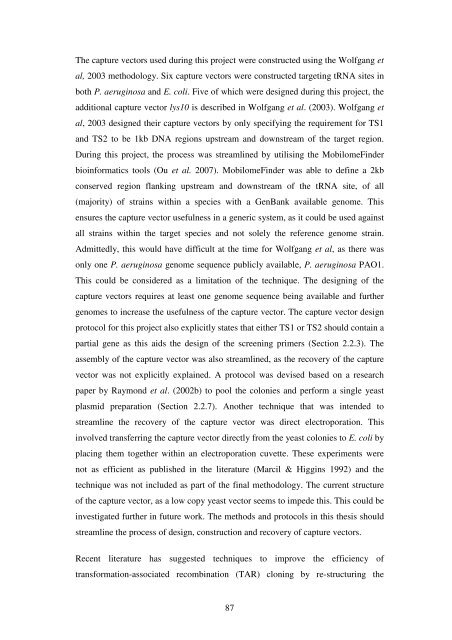5 The role of quorum-sensing in the virulence of Pseudomonas ...
5 The role of quorum-sensing in the virulence of Pseudomonas ...
5 The role of quorum-sensing in the virulence of Pseudomonas ...
Create successful ePaper yourself
Turn your PDF publications into a flip-book with our unique Google optimized e-Paper software.
<strong>The</strong> capture vectors used dur<strong>in</strong>g this project were constructed us<strong>in</strong>g <strong>the</strong> Wolfgang et<br />
al, 2003 methodology. Six capture vectors were constructed target<strong>in</strong>g tRNA sites <strong>in</strong><br />
both P. aerug<strong>in</strong>osa and E. coli. Five <strong>of</strong> which were designed dur<strong>in</strong>g this project, <strong>the</strong><br />
additional capture vector lys10 is described <strong>in</strong> Wolfgang et al. (2003). Wolfgang et<br />
al, 2003 designed <strong>the</strong>ir capture vectors by only specify<strong>in</strong>g <strong>the</strong> requirement for TS1<br />
and TS2 to be 1kb DNA regions upstream and downstream <strong>of</strong> <strong>the</strong> target region.<br />
Dur<strong>in</strong>g this project, <strong>the</strong> process was streaml<strong>in</strong>ed by utilis<strong>in</strong>g <strong>the</strong> MobilomeF<strong>in</strong>der<br />
bio<strong>in</strong>formatics tools (Ou et al. 2007). MobilomeF<strong>in</strong>der was able to def<strong>in</strong>e a 2kb<br />
conserved region flank<strong>in</strong>g upstream and downstream <strong>of</strong> <strong>the</strong> tRNA site, <strong>of</strong> all<br />
(majority) <strong>of</strong> stra<strong>in</strong>s with<strong>in</strong> a species with a GenBank available genome. This<br />
ensures <strong>the</strong> capture vector usefulness <strong>in</strong> a generic system, as it could be used aga<strong>in</strong>st<br />
all stra<strong>in</strong>s with<strong>in</strong> <strong>the</strong> target species and not solely <strong>the</strong> reference genome stra<strong>in</strong>.<br />
Admittedly, this would have difficult at <strong>the</strong> time for Wolfgang et al, as <strong>the</strong>re was<br />
only one P. aerug<strong>in</strong>osa genome sequence publicly available, P. aerug<strong>in</strong>osa PAO1.<br />
This could be considered as a limitation <strong>of</strong> <strong>the</strong> technique. <strong>The</strong> design<strong>in</strong>g <strong>of</strong> <strong>the</strong><br />
capture vectors requires at least one genome sequence be<strong>in</strong>g available and fur<strong>the</strong>r<br />
genomes to <strong>in</strong>crease <strong>the</strong> usefulness <strong>of</strong> <strong>the</strong> capture vector. <strong>The</strong> capture vector design<br />
protocol for this project also explicitly states that ei<strong>the</strong>r TS1 or TS2 should conta<strong>in</strong> a<br />
partial gene as this aids <strong>the</strong> design <strong>of</strong> <strong>the</strong> screen<strong>in</strong>g primers (Section 2.2.3). <strong>The</strong><br />
assembly <strong>of</strong> <strong>the</strong> capture vector was also streaml<strong>in</strong>ed, as <strong>the</strong> recovery <strong>of</strong> <strong>the</strong> capture<br />
vector was not explicitly expla<strong>in</strong>ed. A protocol was devised based on a research<br />
paper by Raymond et al. (2002b) to pool <strong>the</strong> colonies and perform a s<strong>in</strong>gle yeast<br />
plasmid preparation (Section 2.2.7). Ano<strong>the</strong>r technique that was <strong>in</strong>tended to<br />
streaml<strong>in</strong>e <strong>the</strong> recovery <strong>of</strong> <strong>the</strong> capture vector was direct electroporation. This<br />
<strong>in</strong>volved transferr<strong>in</strong>g <strong>the</strong> capture vector directly from <strong>the</strong> yeast colonies to E. coli by<br />
plac<strong>in</strong>g <strong>the</strong>m toge<strong>the</strong>r with<strong>in</strong> an electroporation cuvette. <strong>The</strong>se experiments were<br />
not as efficient as published <strong>in</strong> <strong>the</strong> literature (Marcil & Higg<strong>in</strong>s 1992) and <strong>the</strong><br />
technique was not <strong>in</strong>cluded as part <strong>of</strong> <strong>the</strong> f<strong>in</strong>al methodology. <strong>The</strong> current structure<br />
<strong>of</strong> <strong>the</strong> capture vector, as a low copy yeast vector seems to impede this. This could be<br />
<strong>in</strong>vestigated fur<strong>the</strong>r <strong>in</strong> future work. <strong>The</strong> methods and protocols <strong>in</strong> this <strong>the</strong>sis should<br />
streaml<strong>in</strong>e <strong>the</strong> process <strong>of</strong> design, construction and recovery <strong>of</strong> capture vectors.<br />
Recent literature has suggested techniques to improve <strong>the</strong> efficiency <strong>of</strong><br />
transformation-associated recomb<strong>in</strong>ation (TAR) clon<strong>in</strong>g by re-structur<strong>in</strong>g <strong>the</strong><br />
87














